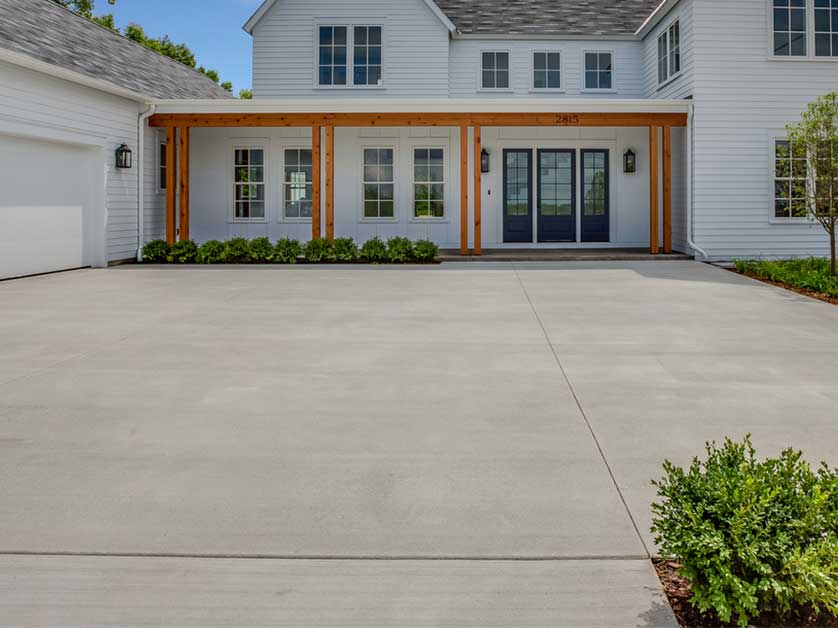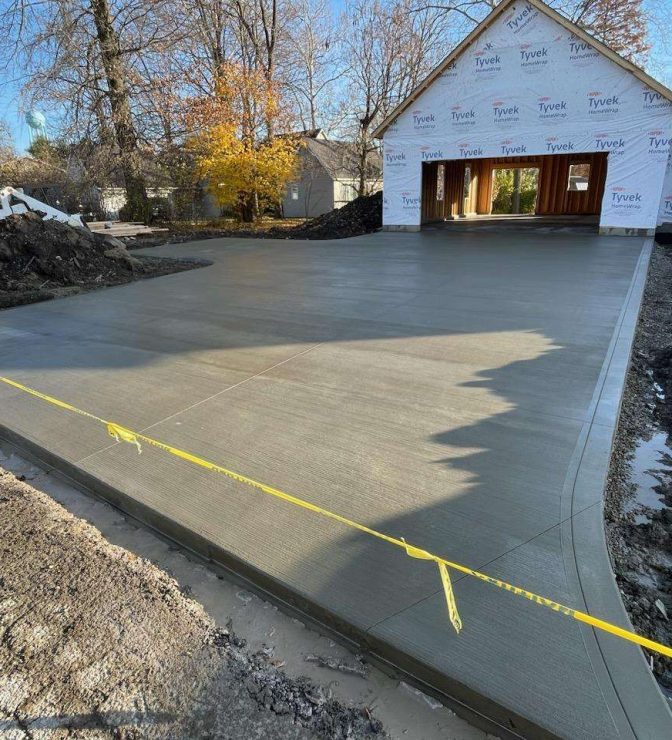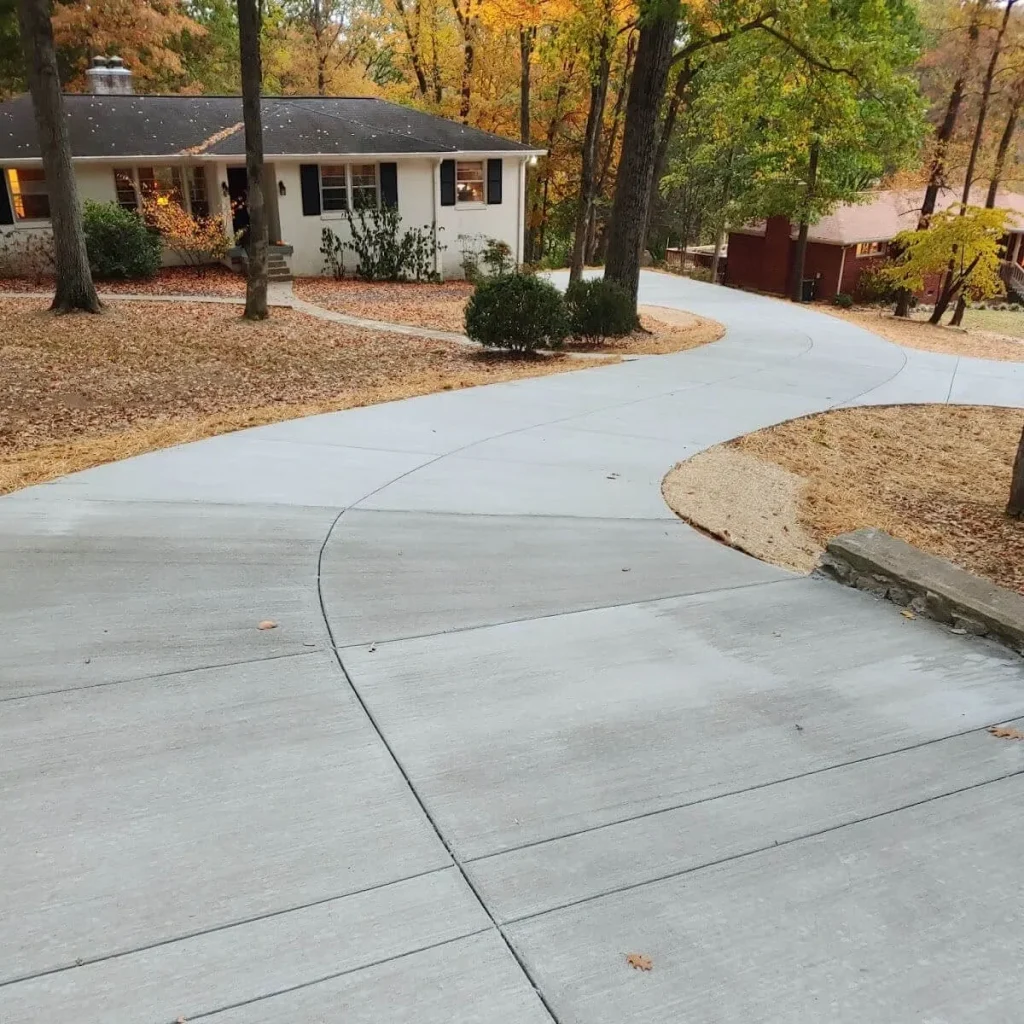
When it comes to driveway installation, particularly with concrete, there are common pitfalls that homeowners and commercial property owners in Geelong often overlook.
As experienced concrete contractors, we’ve seen how small mistakes during installation can lead to long-term issues, impacting both the durability and aesthetic appeal of the driveway.
In this guide, we’ll dive into seven major driveway installation mistakes and offer practical advice on how to avoid them, saving you time, money, and unnecessary headaches.
Table of Contents
- Poor Ground Preparation
- Skipping Reinforcement
- Using Substandard Materials
- Incorrect Concrete Thickness
- Ignoring Proper Drainage
- Insufficient Curing Time
- Lack of Professional Installation Leads to Driveway Installation Mistakes

1. Poor Ground Preparation
One of the most common mistakes during driveway installation is insufficient ground preparation. Concrete requires a solid, well compacted base to prevent cracking and sinking.
Without proper excavation and grading, your driveway may become uneven or develop weak spots. Before any concrete is poured, the site needs to be cleared of loose soil and debris.
When avoiding common driveway installation mistakes, a subgrade should be compacted with gravel or crushed stone, ensuring it’s both level and stable. Skipping this step or cutting corners often leads to costly repairs down the line.
2. Skipping Reinforcement
One of the common driveway installation mistakes is overlooking the need for reinforcement. Concrete, by its nature, isn’t flexible and requires reinforcement—typically steel bars (rebar) or mesh—to handle the stresses of daily use, such as vehicle weight and ground shifts. Many DIY installers assume that the thickness of the concrete alone is enough, which is a critical misstep.
In reality, the absence of reinforcement can lead to cracking and weakening over time. To avoid this, always include a robust reinforcement plan based on the driveway’s expected load, especially for larger vehicles.
3. Using Substandard Materials
The quality of materials plays a vital role in the longevity of your concrete driveway. Low grade concrete mixes often contain too much water, reducing the driveway’s strength and making it more susceptible to wear and tear.
Avoiding common driveway installation mistakes involves using a proper mix, ideally a high strength one with a ratio suited for Geelong’s weather conditions, which is essential for both residential and commercial applications. Additionally, using high quality aggregate and sand will help improve durability and resistance to cracking.
4. Incorrect Concrete Thickness
Concrete thickness is a crucial factor in driveway installation. Many installations fail because the concrete is poured too thin. For a standard residential driveway, the minimum recommended thickness is 100mm, while driveways handling heavier vehicles should be thicker, around 125mm.
One of the common driveway installation mistakes is inadequate thickness, which can lead to premature cracking and erosion under the stress of heavy traffic. It’s essential to consult with professionals who understand the appropriate thickness requirements based on the driveway’s intended use.
5. Ignoring Proper Drainage
One of the common driveway installation mistakes is failing to account for water drainage. Water that pools on the surface can seep into the concrete, causing cracks when it expands during cold weather.
Over time, this also weakens the subgrade, leading to instability. To prevent this, the driveway should have a slight slope (about 1-2%) away from buildings to ensure proper water runoff. Additionally, installing drainage channels at key points can help redirect excess water away from the driveway’s foundation.
6. Insufficient Curing Time
One of the common driveway installation mistakes is not allowing the concrete to cure properly. Concrete doesn’t reach full strength immediately after pouring—it requires proper curing. Many driveways fail prematurely because the concrete wasn’t allowed to cure long enough before use.
Ideally, concrete should be left to cure for at least 7 days, with lighter use allowed after this period, but full curing can take up to 28 days. Rushing this process by driving on the surface too soon can lead to cracks and a weakened structure.
A professional contractor will ensure the driveway has sufficient time to cure, maximising its lifespan.
7. Lack of Professional Installation Leads to Driveway Installation Mistakes
Lastly, one of the common driveway installation mistakes is attempting a DIY installation. While some property owners try to install concrete driveways themselves, these projects are best left to experienced professionals. Misjudging factors like base preparation, material quality, and curing time often leads to avoidable mistakes.
A professional contractor not only brings expertise but also ensures that local regulations and standards are met. They can advise on the best materials, reinforcement methods, and finishing options, offering you peace of mind that your driveway will stand the test of time.

Why Choose Us for Your Concrete Driveway?
Here are five reasons why you should trust our team for your next driveway project:
- Expertise – We have extensive experience in residential and commercial concrete works, from driveways to patios and pathways.
- Durable Materials – We use only high-quality concrete mixes and reinforcements suited for Geelong’s climate and soil conditions.
- Precision Installation – Our team ensures proper preparation, grading, and reinforcement, avoiding the common pitfalls outlined above.
- Customer Focused – We work closely with you, ensuring all your specifications are met, from drainage planning to finishing touches.
- Free Quotes – We offer detailed, obligation-free quotes, so you know exactly what to expect from the outset.
Avoid common driveway installation mistakes by contacting us today for more information or to request your free quote. Let’s work together to build a driveway that lasts for years to come.
FAQs
Poor ground preparation can significantly affect driveway installation by leading to an unstable surface that is prone to cracks, sinking, or premature deterioration. If the soil beneath the concrete is not properly compacted, it may settle unevenly over time, causing the driveway to shift or develop potholes. Additionally, if there are organic materials, loose soil, or moisture-rich areas in the subgrade, they can weaken the foundation, leading to structural failures. Proper ground preparation, including excavation, compaction, and the use of a stable base material such as crushed rock, ensures the driveway remains strong and level for many years. Investing time and effort into this crucial first step prevents costly repairs and extends the life of the driveway.
Reinforcement is necessary for concrete driveways because it significantly enhances strength and durability, reducing the likelihood of cracking and structural damage. Concrete itself is strong in compression but weaker in tension, meaning it can crack under stress if not properly reinforced. Steel reinforcement, such as rebar or steel mesh, helps distribute loads more evenly across the slab, preventing stress points that could lead to fractures. This is especially important in driveways that experience heavy vehicle traffic or are built on soil that may shift over time. Reinforcement also helps the concrete resist the effects of temperature fluctuations, which can cause expansion and contraction, ultimately leading to cracks if not properly managed.
The recommended thickness for a concrete driveway is typically 100mm for standard passenger vehicles, but for heavier loads, such as trucks or caravans, increasing the thickness to 125-150mm is advisable. A thicker slab provides additional strength and resistance to cracking, particularly in high-traffic areas or regions where the soil is less stable. The thickness of the concrete also plays a role in how well the driveway distributes weight, preventing stress fractures that could develop over time. Additionally, thicker slabs allow for better reinforcement placement, further improving the driveway’s longevity. Ensuring the correct thickness is used from the outset helps prevent premature wear and expensive repairs.
Poor drainage can seriously damage a concrete driveway by allowing water to accumulate on the surface or seep into the base, leading to long-term structural problems. When water infiltrates the subgrade, it can weaken the soil and cause it to shift, leading to sinking or uneven areas in the driveway. In colder climates, trapped water can freeze and expand, causing the concrete to crack through a process known as freeze-thaw damage. Even in warmer areas, prolonged exposure to moisture can lead to erosion of the base material, reducing the driveway’s overall stability. To prevent these issues, driveways should be designed with a slight slope for proper runoff, and additional drainage solutions such as gravel beds, trench drains, or expansion joints may be necessary to direct water away from the surface.
Concrete should cure for at least seven days before being used by vehicles, but for optimal strength and durability, a full curing period of 28 days is recommended. During the curing process, the concrete undergoes chemical hydration, gradually gaining strength as it hardens. If concrete is used too soon, it may not have developed enough resistance to stress, leading to premature cracking or surface damage. To ensure proper curing, the surface should be kept moist by spraying it with water or using curing compounds to retain moisture. Covering the driveway with plastic sheeting or wet burlap can also help maintain the right conditions for even curing. Allowing the concrete to cure properly ensures it reaches its full strength and can withstand daily wear and tear.
The ideal concrete mix for driveways should have a strength of at least 25 MPa to ensure it can handle vehicle loads and resist cracking. The mix should include high-quality cement, well-graded sand, crushed stone or gravel, and the appropriate amount of water to create a strong and workable consistency. Some mixes also contain additives such as plasticisers, which improve workability, or air-entraining agents, which enhance resistance to freeze-thaw damage. In areas with extreme weather conditions, special additives may be used to improve durability and prevent moisture-related deterioration. Using the correct concrete mix is crucial in ensuring the driveway maintains its structural integrity and resists wear over time.
While it is possible to install a concrete driveway as a DIY project, hiring a professional is highly recommended to ensure the job is done correctly and to a high standard. Professionals have the necessary experience, tools, and knowledge to properly prepare the ground, mix and pour the concrete, and apply finishing techniques that improve both durability and appearance. Mistakes in driveway installation, such as improper thickness, poor compaction, or incorrect curing methods, can lead to long-term issues like cracking, uneven surfaces, or drainage problems. A professionally installed driveway is more likely to last for decades with minimal maintenance, making it a worthwhile investment. In the long run, hiring an expert can save money by preventing costly repairs and ensuring a high-quality finish that enhances the overall look of your property.

